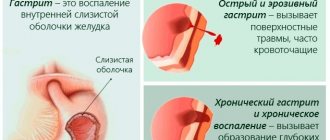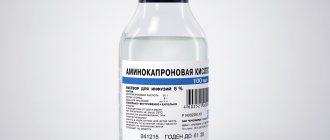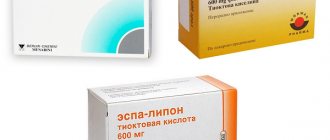Instructions for use Calcium pantothenate (method and dosage)
For adult patients, calcium pantothenate is prescribed in a dosage of 0.1-0.2 g two to four times a day. Children under three years of age should take a dosage of 0.05-0.1 g at a time. For children from three to fourteen years old, the vitamin complex is usually prescribed in a dosage of 0.1-0.2 g at a time, twice a day.
The permissible dose for adults is 0.4-0.88 g. The permissible dose for children is 0.1-0.4 g.
In the presence of intestinal atony, it is recommended to take the drug 0.25 g every six hours.
When administering the vitamin complex parenterally, the dosage for adult patients is 0.2-0.4 g (2-4 ml of a 10% solution or 1-2 ml of a 20% solution) once or twice a day. For children under three years of age, the drug is administered at a dosage of 0.05-0.1 g (0.5-1.0 ml of a 10% solution) once or twice a day.
The duration of treatment is on average three to four months.
In the treatment of skin diseases, this drug is prescribed in large doses. For adult patients it is 1.5 g per day. The children's dosage corresponds to 0.1-0.3 g two to three times a day.
In case of withdrawal syndrome, the drug is administered intramuscularly or intravenously at 0.5 g per day (5 ml of 10% solution). In acute alcoholic psychosis, 1 g (10 ml of a 10% solution) should be administered for ten days.
In the treatment of respiratory diseases, calcium pantothenate is usually used in the form of inhalations. In this case, the dosage is 0.2 g of a 4% solution diluted in 5 ml of water. Inhalations should be carried out for seven to eight days. The average duration of one procedure is ten to fifteen minutes.
general information
Calcium pantothenate is a white crystalline compound.
Easily dissolves in water. The acid preparation was produced in the form of tablets, injection solution, and powder. In the human body, it is produced by intestinal microflora, and therefore its additional intake is rarely prescribed. Solgar, Pantothenic Acid, 550 mg, 100 Veggie Caps
1 174 ₽
Buy at a discount
Calcium pantothenate is involved in the regulation of phosphorus-calcium metabolism. It ensures normal functioning of the nervous system and enhances capillary blood circulation. The vitamin is often confused with hopantenic acid (Pantogam, Pantocalcin), claiming that they are the same thing - they have similar functions and similar names, but have different chemical formulas and properties.
The table below provides basic information about the active substance:
| Latin name | Pantothenic acid, d-calcium pantothenate |
| Active ingredient | Pantothenic Acid (D-Calcium Pantothenate) |
| Manufacturer | Not produced in the Russian Federation in its pure form. Made in the USA (Solgar, Now Foods, Solaray, Nature's Way, Life Extension, Country Life) |
Calcium pantothenate supports energy metabolism and improves the functioning of the nervous system.
What it is
Patients are prescribed to take the drug for the purpose of preventing or treating diseases caused by a lack of vitamin B. People suffer from deficiency as a result of insufficient or malnutrition, as well as if intestinal absorption is impaired or significantly reduced. The body obtains calcium pantothenate from both animal and plant foods, including meat, liver, bran, legumes (except green beans), vegetables, milk and eggs, fish eggs and yeast. In addition, the substance is also produced by E. coli living in the human body. It should be remembered that indications for additional intake of pantothenic acid can only temporarily replenish substances missing in the body, but are in no way a complete replacement for naturally necessary food.
Calcium D-pantothenate
Active substance:
Calcium pantothenate*
Pharmgroup:
Vitamins and vitamin-like products
Average price in pharmacies
| Name | Manufacturer | average price |
| Calcium gluconate 0.5 n10 tablet/ubf | URALBIOPHARM | 6.99 |
| Calcium gluconate 0.5 n120 tablet | EVALAR | 84.00 |
| Calcium gluconate 0.5 n20 tablet | PHARMSTANDARD | 32.00 |
| Calcium gluconate 0.5 n20 tablet/tathimpharm/ | TATHIMPHARMA PREPARATIONS | 19.99 |
| Calcium gluconate 0.5 n30 tablet/ubf | URALBIOPHARM | 28.00 |
Analogs for the active substance:Calcium pantothenate |
Indications for use
Calcium pantothenate is prescribed in the following cases:
- decreased circulatory activity in tissues;
- nutritional deficiency in pregnant women with acute toxicosis;
- neurological disorders and polyneuritis;
- decreased tone of the smooth muscles of the small intestine;
- acute bronchitis, asthma;
- chronic allergic reactions;
- withdrawal syndrome;
- skin lesions (eczema, trophic ulcers);
- extensive burns.
During gestation and during breastfeeding, it is used to restore the balance of nutrients - in case of acute toxicosis or in the postpartum period. It does not affect the intensity of lactation, and therefore can be taken by nursing women.
It is prescribed for children for cerebrovascular accidents caused by birth injuries or neurological disorders. Also used for delayed physical and mental development. When treating children, it is highly undesirable to exceed the recommended dosage and use the drug in the afternoon, as this may cause increased excitability.
The video reflects the indications for the use of the vitamin, methods of use and recommended dosages:
https://www.youtube.com/watch?v=nZprCHVwOYw
METABOLISM OF VITAMIN B5
Every day, the intestinal microflora of a healthy body synthesizes 3.4 milligrams of vitamin B5. After food intake, pantothenic acid is absorbed by diffusion directly from the intestine into the blood and tissues, where it is subsequently captured by red blood cells and actively transformed into coenzyme forms - coenzyme A and phosphopantothein. The remaining part of the substance circulates in the body in a free state. The catabolism of organic compounds of non-protein nature is based on their hydrolysis, while “waste” calcium pantothenate and its metabolites are excreted in the urine.
Vitamin B5 is sensitive to heat; heat treatment of foods rich in the beneficial compound leads to a loss of 50% of the substance. It is destroyed not only under the influence of dry heat (grill, oven), but also as a result of exposure to solutions of acids and alkalis that are used in food processing, for example, during canning and freezing.
It is important to remember that pantothenic acid is found in foods exclusively in protein form and is released with the help of enzymes.
Contraindications and side effects
In general, no problems or side effects were noted with calcium pantothenate. Analogues are also well tolerated, but each of them should be considered separately. Extremely rarely, usually due to overdose, azotemia, heartburn, nausea and vomiting may be observed. All symptoms are relieved when the drug is discontinued. Sometimes patients noted pain in the area of intramuscular injection and the appearance of an infiltrate.
Tolerability of any drug in patients is purely individual. In the case of vitamin B₅, you need to be careful when prescribing it to patients who are hypersensitive to the constituent elements of the substance. It should be remembered that the drug enhances the effect of cardiac glycosides. Reduces the toxic effects of many substances and can reduce the effectiveness of some of them.
Interaction
This remedy should not be used earlier than 12 hours after using Proserin and Ditilin .
Calcium Pantothenate improves the energy supply of myocardial contractile function and the therapeutic effect of cardiac glycosides . In addition, it reduces the toxic effects of aminoglycosides , sulfonamides , drugs with arsenic and streptomycin antibiotics .
Reviews
There is information that calcium pantothenate has received positive reviews in the fight against many and completely different diseases. Namely, it was effective: for stabilizing attention deficit and hyperactivity, for autism and Parkinson's disease, in the treatment of alcoholism, for baldness, fungal infections, for heart failure, for low blood sugar, colitis, cystitis, convulsions, conjunctivitis. It is also taken and is said to have a positive effect on depression and anxiety, headaches and insomnia, irritability, lowering blood pressure, muscular dystrophy, and obesity. Pantothenic acid is used for rheumatoid and osteoarthritis, relieves chronic fatigue syndrome and dizziness. Creams containing pantothenic acid relieve itching and promote healing of mild eczema and other skin conditions, they help with insect bites, poison ivy burns, diaper rash and pimples. Creams and ointments have been used successfully to prevent and treat skin reactions to radiation therapy. Calcium pantothenate is also used in bodybuilding as a powerful anabolic steroid that promotes rapid mass gain.
Regardless of the overall successful use of D-calcium pantothenate, it should be remembered that it was created only to help in difficult situations in the fight against the disease. It cannot replace a healthy diet, and therefore you should monitor its completeness and timeliness. Don't forget about exercise and how bad habits can slowly destroy our body. Your health is in your hands.
Be healthy!
Analogs of Calcium Pantothenate
Level 4 ATC code matches:
Medobiotin
Volvit
Nicotinamide
Alpha Tocopherol Acetate
Riboflavin
Pyridoxine Hydrochloride
Pyridoxine
Vitrum Vitamin E
Calcium Pantothenate analogues are very widespread, but none of them should be replaced independently, without consulting a specialist.
Well-known analogues of Calcium Pantothenate are Aminalon , Neuro-norm , Noobut , Noozam , Noofen and Vasavital . These drugs are prescribed for various diseases of the nervous system. In addition, analogues such as Olatropil , Pantogam , Picamilon , Semax , Phenotropil , Ceregin Evrysam , Omaron , Pantocalcin , Pramistar , Phezam , Ceregin , Evrysam , etc. are also popular.
IMPORTANCE OF VITAMIN B5
Pantothenic acid is involved in protein, fat, carbohydrate metabolism, cholesterol metabolism, the synthesis of a number of hormones, hemoglobin, promotes the absorption of amino acids and sugars in the intestines, and supports the function of the adrenal cortex. A lack of pantothenic acid can lead to damage to the skin and mucous membranes.
Vitamin B5 is a structural component of the key substance of metabolism - coenzyme A, which is involved in all types of metabolism - protein, lipid, carbohydrate, in the synthesis of hemoglobin, choline, the neurotransmitter acetylcholine, corticosteroids, adrenal hormones and in the processes of detoxification of the body by transferring acyl residues.
Considering the fact that vitamin B5 and its derivatives interact with a large number of substances inside our body, it is impossible to list them completely. However, in order to be convinced of the significance of the connection, we will consider the most significant of them. These are cholesterol, acetylcholine, fats, fatty acids, histamine, hemoglobin, amino acids, carbohydrates.
Participating in the synthesis and metabolic processes of such a variety of substances, for the proper functioning of all systems and internal organs, it is important to ensure a regular supply of calcium pantothenate in sufficient quantities.
Let's look at why the body needs vitamin B5.
- Activity of the adrenal glands. Scientists have proven that the cortex of these organs is the most efficient gland in humans, which is capable of producing hormones for six hours a day, but for this it needs significant reserves of calcium pantothenate in order to fight pathogenic microbes and increased psycho-emotional stress. First of all, , the acid is involved in the synthesis of hormones of the endocrine glands. At the formation stage, all glucocorticoids are associated with coenzyme A, and one way or another, their production in sufficient quantities is a reliable prevention of allergies, colitis, arthritis, and heart diseases. Vitamin B5 has an anti-inflammatory effect. Participating in the course of metabolic processes in the adrenal cortex, it synthesizes glucocorticoids, which “turn on” the body’s protective reaction in the event of the introduction of foreign microorganisms.
- Synthesis of fatty acids. As you know, these monobasic carbonic substances are necessary for the connection of fats and normal brain function. As a result, vitamin B5 normalizes metabolism and activates human mental activity. As a side effect, fat deposition in the body is regulated. Therefore, pantothenic acid is an essential vitamin for weight loss and eliminating metabolic problems.
- The work of the nervous system. Calcium pantothenate is involved in the synthesis of mediators, hormones, neurotransmitters, which ensure the proper development of the nervous system in children, adolescents, and adults. Daily intake of 5 milligrams of vitamin B5 prevents the onset of Alzheimer's disease and senile dementia. One of the most important reactions occurring with the participation of pantothenic acid in the body human - the conversion of choline into acetylcholine, through which communication signals (impulses from the sensory organs) pass, which explains the high concentration of the beneficial compound in brain cells.
- Maintaining immunity. Unlike vitamins A and E, which fight free radicals, bacteria, viruses, activating the body’s protective function, the biological role of pantothenic acid is the synthesis of antibodies. B5 deficiency leads to a sharp decrease in the amount of immunoglobulins, as a result, a person becomes more vulnerable to the harmful influence of pathogens from the outside.
- Normalization of cholesterol metabolism. Calcium pantothenate inhibits the process of plaque clogging of arteries by regulating the synthesis of fatty acids. Thanks to this property, vitamin B5 is a natural “drug” that effectively fights atherosclerosis.
- Energy production. Pantothenic acid triggers the process of lipolysis in the body - the release of triglycerides from fat cells and their subsequent burning. These procedures are accompanied by the production of additional energy, which is needed during intense physical activity and increased mental work.
- Promotes rapid healing of wounds, tissue renewal, and restoration of the barrier properties of mucous membranes.
- Relieves depressive disorders, forgetfulness, absent-mindedness, doubts.
- Prevents side effects from antibiotics.
- Reduces pain in rheumatoid arthritis.
In addition, pantothenic acid is needed to maintain healthy skin and hair. It prevents the formation of wrinkles, the premature appearance of age spots, and inhibits early gray hair. By participating in the synthesis of corticosteroids and hemoglobin, B5 has a positive effect on the fight against stress.
Calcium pantothenate is the only vitamin that can be absorbed through the skin; thanks to this property, the substance is used in the production of anti-burn medications and cosmetics.
Thus, it is extremely difficult to overestimate the positive properties of organic matter, since the slightest deficiency will immediately affect the functioning of almost all organs and systems.
Forms of drug production
The instructions for use of calcium pantothenate indicate the following forms of the drug:
- tablets for oral administration;
- powder for preparing suspensions;
- 10% solution for injection in ampoules;
- 20% solution for injection in ampoules.
B5 is commercially available in the form of capsules and tablets.
The table below shows the main forms of release:
| Manufacturer | Release form | Dosage, mg | Quantity per package, pcs |
| Solgar | Vegetable capsules | 550 | 100 |
| Now Foods | Capsules | 500 | 250 |
| Solaray | Vegetarian capsules | 500 | 250 |
| Nature's Way | Capsules | 250 | 100 |
| Life Extension | Vegetarian capsules | 500 | 100 |
| Country Life | Pills | 1000 | 60 |
Nature's Plus, Pantothenic Acid, 1000 mg, 60 Tablets
★★★★★
1 271 ₽
Buy at a discount
Solaray, Pantothenic Acid, 500 mg, 250 Veggie Caps
★★★★★
1 367 ₽
Buy at a discount
Solgar, Pantothenic Acid, 550 mg, 100 Veggie Caps
★★★★★
1 175 ₽
Buy at a discount
Properties of the drug
Calcium pantothenate is the calcium salt of pantothenic acid. It is part of a coenzyme that takes part in oxidative processes and acetylation. Participates in the formation of acetylcholine, carbohydrate and fat metabolism.
Synthesized by intestinal microflora. Contained in the upper layer of the adrenal cortex and stimulates the formation of steroids in the body. Takes part in regenerative processes, enhances tissue trophism. Regulates the energy component of myocardial contractions.
After administration, it is quickly absorbed in the small intestine. During metabolism, calcium pantothenate is converted from a salt to pantothenic acid. About 60% is excreted through the kidneys, the rest in the stool.
Instructions:
Clinical and pharmacological group
17.020 (Multivitamins with macroelements)
Release form, composition and packaging
◊ Film-coated tablets of light yellow, orange, green or reddish-brown color, round, biconvex; inclusions are allowed.
| 1 tab. | |
| retinol palmitate (vit. A) | 600 IU |
| colecalciferol (vit. D3) | 80 IU |
| ascorbic acid (vit. C) | 10 mg |
| thiamine mononitrate (vit. B1) | 250 mcg |
| riboflavin (vit. B2) | 300 mcg |
| calcium pantothenate (vit. B5) | 1.2 mg |
| pyridoxine hydrochloride (vit. B6) | 300 mcg |
| folic acid (vit. Bc) | 40 mcg |
| cyanocobalamin (vit. B12) | 0.2 mcg |
| Nicotinamide (Vit.PP) | 3 mg |
| calcium (in the form of hydrogen phosphate) | 12.5 mg |
| phosphorus (in the form of hydrogen phosphate) | 10 mg |
Excipients: mannitol, raspberry flavor, polysorbate 80, glycerol, castor oil, maltitol (in the form of 75% solution), magnesium stearate, emulsion wax (Capol 600 Pharma), povidone, anhydrous colloidal silicon dioxide, maltitol, butylated hydroxyanisole and butylated hydroxytoluene (as part of retinol palmitate), D,L-α-tocopherol and medium chain triglycerides (as part of colecalciferol).
1 yellow tablet additionally contains: titanium dioxide (E171) and betacarotene 1% CWS (E 160a). 1 orange tablet additionally contains: titanium dioxide (E 171) and betacarotene 10% CWS (E 160a). 1 additional green tablet contains: indigo carmine dye (E 132), quinoline yellow dye (E104), titanium dioxide (E171). 1 red tablet additionally contains: red iron oxide dye (E 172).
10 pieces. - blisters (3) - cardboard packs.
pharmachologic effect
Multivitamins with macroelements. Pikovit® D contains the 10 most important vitamins, as well as calcium and phosphorus.
B vitamins (B1, B2, B6, B12, pantothenic acid and nicotinamide) are involved in the metabolism of carbohydrates, proteins and fats.
Folic acid (vitamin Bc) is inactive, but in the body it is converted into a biologically active coenzyme - tetrahydrofolic acid, which is necessary for the biosynthesis of nucleic acids. It enhances growth and is involved in the maturation of red blood cells. Folic acid is involved in the formation and regeneration of platelets and their function.
Retinol (vitamin A) is necessary for the development of epithelial cells and the synthesis of visual pigment.
Colecalciferol (vitamin D) is involved in calcium metabolism and promotes proper mineralization of bones and teeth.
Ascorbic acid (vitamin C) accelerates the absorption of iron and takes part in many redox processes in the body.
Calcium and phosphorus play a key role in the mineralization of bones and teeth. Calcium ions activate numerous enzymes; they take part in regulating the tone of the heart muscle, in the transmission of nerve impulses and regulate the permeability of cell membranes.
Water-soluble vitamins (B vitamins, vitamin C and biotin) are well absorbed in quantities that meet the body's daily needs. Amounts exceeding tissue saturation levels are excreted by the kidneys and, to a lesser extent, through the gastrointestinal tract.
After oral administration, fat-soluble vitamins A and D are well absorbed from the small intestine in the presence of fat. Higher amounts of fat-soluble vitamins accumulate in the liver and are therefore more toxic than water-soluble vitamins.
Vitamin and mineral tablets Pikovit® D do not contain sugar.
The drug contains the sweeteners maltitol and mannitol, which do not have any adverse effects on teeth.
Dosage
Use of the drug in children under 14 years of age is recommended by a doctor.
For children aged 4 to 6 years, use 1 tablet. 4-5 times/day.
For children aged 7 to 14 years, use 1 tablet. 5-7 times/day.
The tablets should be kept in the mouth until completely dissolved.
The duration of treatment is 1 month. The need for longer-term use of the drug is determined by the doctor.
Overdose
Symptoms: with long-term use of the drug (>1 month) in high doses, hypervitaminosis A and D is possible. With long-term use of vitamin B6 in high doses, peripheral neuropathy is possible. Mannitol and maltitol are not sufficiently absorbed from the gastrointestinal tract and in high doses can cause diarrhea and flatulence. A laxative effect develops when taking maltitol >60 g/day (66 film-coated tablets) or mannitol >10 g/day (68 film-coated tablets).
Treatment: symptomatic therapy.
Drug interactions
Data on drug interaction of the drug are not provided.
Use during pregnancy and lactation
Data on the use of the drug during pregnancy and breastfeeding are not provided.
Side effects
Allergic reactions are possible. In such cases, you should stop using the drug and consult your doctor.
Due to the presence of 0.9 g of maltitol in Pikovit® D tablets, diarrhea may develop when doses exceeding the recommended ones are used.
Storage conditions and periods
The drug should be stored out of the reach of children, in a dry place, protected from light, at a temperature not exceeding 30°C. Shelf life: 3 years.
Indications
Conditions accompanied by an increased need in children for vitamins, calcium and phosphorus:
- decreased or lack of appetite;
— overwork in school-age children;
- as an adjuvant therapy when taking antibiotics;
- inadequate and unbalanced nutrition (including as a result of insufficient consumption of fresh vegetables and fruits).
Contraindications
- hypervitaminosis A;
— hypervitaminosis D;
— severe renal failure (creatinine clearance<30 ml/min);
- children under 4 years of age;
- hypersensitivity to the components of the drug.
special instructions
Children should not be given higher doses than recommended.
Long-term use of the drug in high doses can cause hypervitaminosis A and D, although the likelihood of overdose is minimal.
If it is necessary to use other multivitamin-mineral complexes at the same time, consult your doctor.
Patients with diabetes can take Pikovit® D. But it should be remembered that 1 tablet contains 0.9 g of maltitol, i.e. The daily dose is 3.6-6.3 g of maltitol. Insulin is required for the metabolism of maltitol, although due to slow hydrolysis and absorption in the gastrointestinal tract, the need for insulin is low. The energy value of maltitol (10 kJ/g or 2.4 kcal/g) is less than that of sucrose.
Use for renal impairment
The use of the drug is contraindicated in severe renal failure (creatinine clearance <30 ml/min).
Conditions for dispensing from pharmacies
The drug is approved for use as a means of OTC.
special instructions
If there are disturbances in the intestinal microflora, a higher dosage of the vitamin may be required. Also, an increased rate is required for people exposed to regular physical and mental stress. The active substance is destroyed at temperatures above 50 0C, so consuming thermally processed foods cannot always cover the body’s need for the vitamin.
It is recommended to take pantothenic acid supplements in the morning. Pregnant and breastfeeding women are advised to start taking it only after consulting a doctor. It is not recommended to exceed recommended doses when using the product by children.
Nature's Way, Pantothenic Acid, 250 mg, 100 Capsules
812 ₽
Buy at a discount
Recommended dosage
You should take the tablets in the first half of the day with plenty of water. In case of postoperative absence of intestinal smooth muscle tone, 250 mg is administered every 6 hours. In other cases, calcium D pantothenate is taken 1-2 times a day. Recommended daily dosages for use:
- children under 3 years old - 50-100 mg;
- children from 3 to 14 years old - 100-200 mg;
- children over 14 years of age and adults - 200-400 mg;
- pregnant women - 200-500 mg;
- nursing - 300-700 mg.
When treating alcohol intoxication and withdrawal syndrome, the daily dosage is 500-1000 mg. The instructions for the calcium pantothenate preparation indicate that for the treatment of dermatitis the daily dosage can be increased to 1500 mg. The exact dose for each individual case is calculated by the attending physician, based on the patient’s condition, age and severity of the disease.
Means with similar effects
As acid analogues, drugs from the group of nootropics are indicated:
- Pantocalcin. Hopantenic acid preparation. Produced in tablets and syrup. Prescribed for brain damage and disorders of the nervous system. Can be used from birth.
- Phenotropil. Increases mental activity, enhances the ability to concentrate. Enhances physical performance and helps reduce the pain threshold. It is not recommended to use in the afternoon as the product may affect sleep.
- Pantogam. A drug containing hopantenic acid. Available in the form of tablets and syrup. It has a pronounced nootropic and vasoconstrictor effect. Used in complex therapy of ischemic brain lesions and neurological disorders.
- Aminalon. Gamma-aminobutyric acid preparation. Produced in the form of tablets and capsules. It has a pronounced neurostimulating and nootropic effect. It is recommended to take the product in the first half of the day to avoid sleep problems.
- Semax. A nootropic drug that is produced in the form of nasal drops. Prevents the occurrence of brain hypoxia, is an antioxidant, protects the tissues of the nervous system from oxygen starvation. Due to the release form, the effect of taking it occurs within a few minutes. Unlike pantothenic acid, it is not used during pregnancy and lactation, as well as in children under 5 years of age.
The price for such drugs ranges from 500 to 1500 rubles.
Knowing what kind of vitamin it is - calcium pantothenate, its chemical properties and role in the body, you can prevent hypovitaminosis in a timely manner. Acid affects metabolism and regulates the activity of the nervous system. Its use accelerates the recovery of the body after interventions, and also contributes to a more rapid relief of withdrawal symptoms.
Reviews, advantages and disadvantages
Reviews of supplements and products containing calcium pantothenate are mostly positive. There is an improvement in well-being, a decrease in overall stress levels, and improved sleep. They also note a decrease in pain during menstruation in women. The condition of hair and skin improves.
Possible disadvantages include the large size of capsules and tablets. It is also noted that the acid preparation is difficult to find in pharmacies, since it is not currently produced in its pure form. You can share your own feedback about your own reception in the form below:
| Leave feedback | |
| 1 2 3 4 5 | |
| Send Cancel | |
Send your review
Calcium pantothenate
Average rating: Number of reviews: 0









